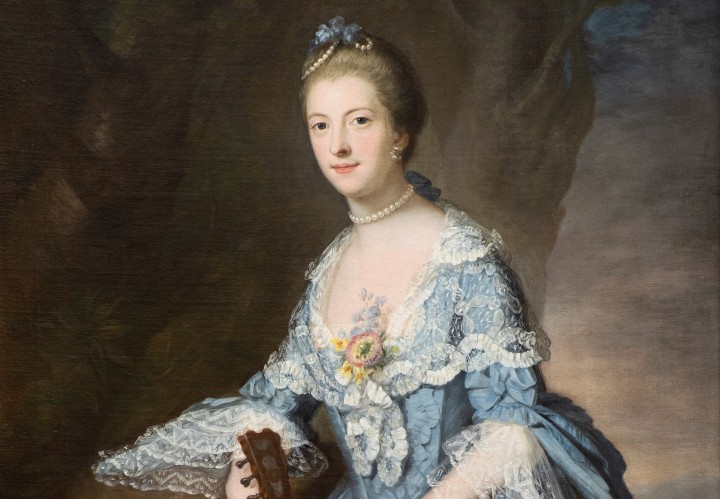Scottish Art News
Latest news
Magazine
News & Press
Publications
‘Determined to confine herself to portraits…’
By Anna Robertson, 28.11.2022

Like many collections, in recent years The Fleming Collection has been working to ensure greater representation from artists representing historically marginalised groups. Their acquisition of two seemingly modest mezzotint portraits is powerful evidence of a significant but forgotten artistic talent. Katherine Read (1723-1778) was probably the first Scottish woman to receive training as an artist. She forged a career as a successful professional artist becoming the most fashionable portrait painter of her day. She was regarded as an equal to any of her male peers including Thomas Gainsborough and Joshua Reynolds, yet today she is almost completely forgotten.
Katherine Read was born in Logie, near Dundee into a well-to-do family. Little is known of her early life, but her talents as an artist were recognised early and she was able to use her family’s Jacobite connections to study under artists in Edinburgh, Paris and Rome. As a woman, Read was prevented from undertaking the full professional training a male artist would expect and she was never able to study life drawing from the nude. Her mentor Abbé Grant observed, “Was it not for the restrictions her sex obliges her to be under I dare safely say she would shine wonderfully in history painting too, but as it is impossible for her to attend public academies or even design or draw from Nature, she is determined to confine herself to portraits”. Read was clearly ambitious and confident of her talents, writing to her brother from Europe “You’ll see I’ll top it with the best of them.” The two mezzotints, newly acquired by The Fleming Collection, show that this ambition was entirely justified.
Read returned from Europe and by 1754 she had established a studio in London. She worked in oil but built her reputation for her work in pastel - the poet William Hayley observed ‘the soft crayon of the graceful Read’. Her career took off when she caught the attention of Queen Charlotte, creating her portrait in 1761 and a subsequent portrait with her new born child Prince George. Read was appointed ‘Painter to the Queen’ in 1763, and two years later painted this portrait of the two toddler Princes and their dog. This was a lucrative format in which she excelled - the affectionate depiction of children, with a beloved pet including dogs, cats, birds and even a horse. The mezzotint by J Watson was published in 1775.
 Katherine Read, Portrait of Willielma Campbell (nee Maxwell), Lady Glenorchy (1741-1786), 1762 [crop]. Courtesy the McManus Collection.
Katherine Read, Portrait of Willielma Campbell (nee Maxwell), Lady Glenorchy (1741-1786), 1762 [crop]. Courtesy the McManus Collection.
In addition to the Royal family, Read’s sitters were members of the Scottish aristocracy and their children, fashionable ladies, singers and actresses. This included the ‘beautiful Gunning sisters’ – Maria and Elizabeth. Born in Ireland of modest means, their beauty was their passport to wealth and status. Elizabeth, Duchess of Hamilton, was a favourite of George III and served as a Lady of the Bedchamber to Queen Charlotte. Read painted this demure portrait in 1769, after the birth of Elizabeth’s fifth child and a year before she became Duchess of Argyll. The portrait remains on display at Inverary Castle, the seat of the Dukes of Argyll and is perhaps Read’s most famous work. It was popularised through John Finlayson’s mezzotints, though later editions were wrongly ascribed to Reynolds - an early intimation of the way in which the achievements of Read’s career were forgotten. Copies of the portrait ‘after’ Read are found in the Royal Collection and the National Trust.
Read created over 300 portraits during her lifetime, many of which were issued as mezzotint prints. Despite being feted during the height of her career – and able to command higher prices than her male peers – she was quickly forgotten. Why? Many of her portraits were created in pastel, a fragile and much marginalised medium. The majority of her portraits were of women and children which remain in the families that commissioned them, so her work rarely comes up for auction. While many collections have the mezzotints that popularised her work, only a small number of public collections have original works by her. In 2020, The McManus was fortunate to acquire her magnificent oil portrait of Willielma, Lady Glenorchy (1741-1786), for their permanent collection. They also have Read’s charming portrait of her niece Helena Beatson on loan.
By 1775, Read’s popularity had started to wane and in 1777, with her niece Helena, she sailed to India. Here she found new clients undertaking several portrait commissions for the Nawab of Arcot and sending a ‘Portrait of an Indian Lady’ back to her family. Struggling with illness and the Indian climate, she set off for home. She died at sea in 1778, eight weeks into her journey back to the UK.
With this acquisition, of mezzotints of two of Read’s most famous portraits, The Fleming Collection highlights an artist at the height of her powers and redresses the marginalisation that left Read’s work languishing in obscurity for over 200 years.
Anna Robertson is the Fine and Applied Art Manager at The McManus: Dundee’s Art Gallery and Museum.
Note, Katherine Read can also be referred to as Catherine Read.




